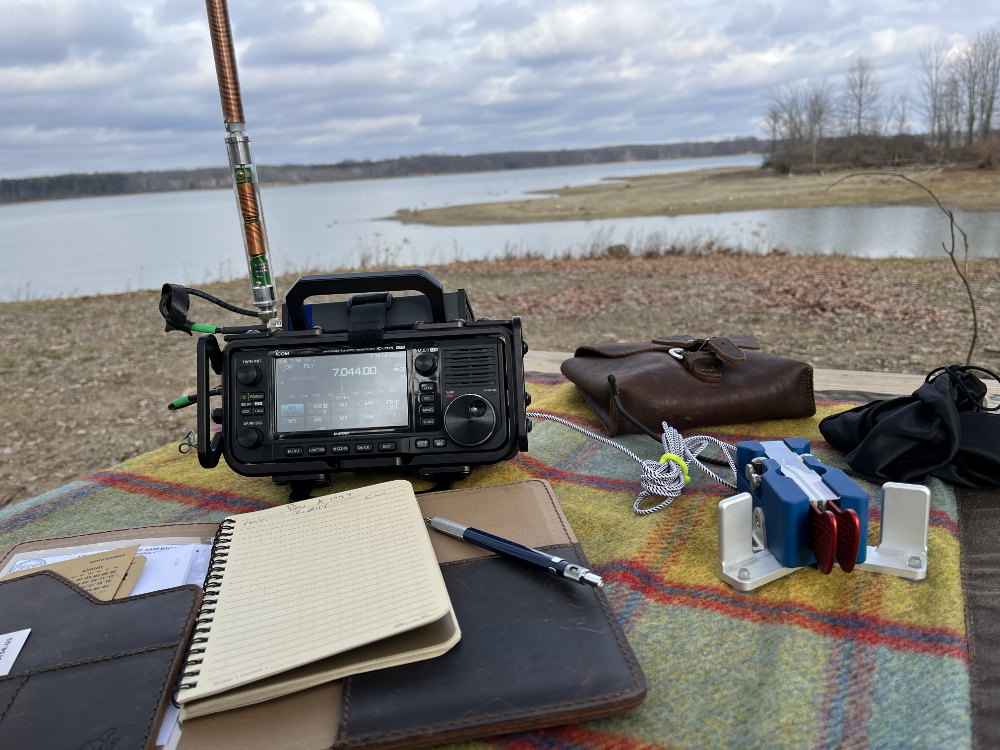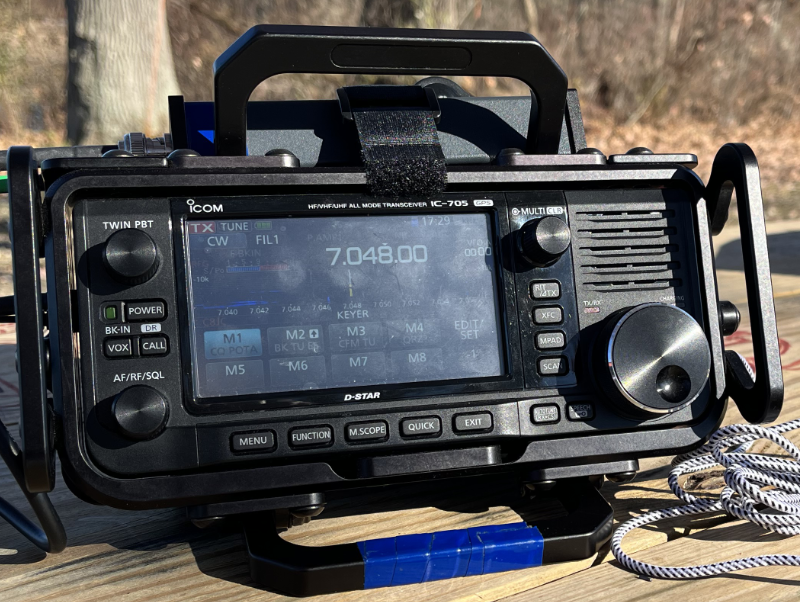What Am I Using?

Field Work
Most of my operating is done portable for Parks on the Air or simply when I’m out camping. As such, I tend to focus a lot more on the station that fits in my backpack than my home station. Maybe that will change someday, but for now, my focus is outside.
I optimize for several factors. The primary optimization is for quick setup and teardown. That means fewer components, less complexity, and different compromises. The second focus is on being less obtrusive when I’m in the field. I’m not actively hiding what I’m doing, I just find that I’m happier when I’m in the field and playing radio when I don’t draw a lot of attention to myself. I also appreciate that parks are public resources. I don’t want my activities to lessen anyone else’s enjoyment of the space. As a result, I like to keep my setup compact and limited to roughly the size of a picnic table in terms of total space utilized.
The gear below is what I’m using right now along with some notes on my current thinking. I will revise this from time to time and keep a change log at the end of the document.
ICOM IC-705

This transceiver could be the basis of anyone’s participation in the hobby. If it were the only rig I owned, I could be quite happy. It covers HF/VHF/UHF and even does D-Star. You have Phone, Digital, and CW all in one unit.
The real magic of this rig is found when using it for any mode that requires a computer. It contains a WiFi unit that allows it to function as an access point or to join a network with other devices. When I do digital work in the field, it is a dream to hook up my computer without any cables. No USB noise and no extra wires getting in my way. In fact, I can sit elsewhere and still control my radio if I wish (I have done this one time and it worked well but isn’t my style of operating).
The current consumption of this radio on receive is beautiful. The battery life is amazing for a rig with a screen and so much functionality. Paired with an external power source (I use a Bioenno 12v 3Ah Lithium Iron Phosphate battery for external power during POTA activations) it will do 10 watts max. I have used it with my Hardrock-50 while camping and found that it was every bit as good as a QRO rig for my purposes. Again, this could be an operator’s only rig and they wouldn’t be missing much of anything.
I have wrapped mine in the Peovi cage and use a Lexan cover for the face. Since I’m often tossing it in my pannier on my bicycle, I find that it’s cheap insurance. I know that I’ve dropped the rig twice with no damage and I credit the however much additional weight in armor for its survival.
The IC-705 is my R2-D2. If mine were lost or stolen, I would replace it on the same day. It’s THAT good.
mAT-705 Plus ATU

mAT was not my favorite with their first attempt at this tuner. It was a terrible design for the end user in that you had to remove the board itself to replace the battery and that was the kind of operation that was going to end in breaking something. At one point, the ATU simply stopped working. I thought about it a long time, but on the Internet I saw that many had switched to the later version, the mAT-705 plus, as it had a USB-C rechargeable battery and was reliable. I’ve been using it for over a year now and that’s all true. It is quite reliable and a useful piece of kit. Also very small and lightweight. I can recommend the plus version without reservation.
Begali Traveller

When I started to learn CW I told myself that when I made a couple of hundred QSOs, I’d get myself a nice key. Begali keys are, well, very nice. Nice is probably the wrong word. When one thinks of Italian craftsmanship and engineering things like sports cars leap to mind for a reason. The Begali Traveller is a very fine machine indeed. My skill level at present doesn’t deserve such a fine piece of equipment, but that’s not the point. I love this thing.
It is very heavy while at the same time being portable. It doesn’t slide around a lot in the field and it comes with a leg strap that I find useful when operating in a (parked) vehicle. It’s also beautiful. Just look at it. LOOK AT IT!
Elecraft AX1

Given that my optimizations are around speed of deployment/packing and discreet operation, the Elecraft AX1 is a very attractive antenna. It fits in my pocket and when deployed takes up no additional space. I can either attach it directly to my radio or ATU or use a really cool mount from Pro Audio Engineering (which is useful for more than just the AX1). In either case, it’s on the picnic table and thus not spiked in the ground or hung in a tree. It’s also not so tall that it garners attention.
I was shocked at the performance of this antenna. It’s just so small that it’s difficult to take seriously, and yet I can’t knock the performance. It’s no EFHW for sure, but it’s far from a dummy load. It’s a high performing compromise antenna for portable use. I imagine that for SOTA it’s a dream come true and that it is no small part of the magic of the KH1. I keep it in my kit at all times because it works and it’s a great fallback to have around.
Chameleon Setup
When I go camping or even take my bicycle out, I usually have my Chameleon setup with me. In the winter, the Hybrid Micro, mounting spike, whip, and a pile of radials live in the Jeep’s trunk. I have all kinds of Chameleon parts that I assemble in various configurations. It is my Go To for camping as it’s always easy to put up a vertical at a state park next to our camper. The basic configuration of a whip or even a whip with an extension is my fastest and most fool-proof setup. It works in all weather and deploys very quickly. All of the parts are heavy duty and as such are great for POTA and camping but I’d never take this setup backpacking.
EFHW
A couple of years ago, when I was first starting out on my POTA journey, I picked up an End-Fedz 10/20/40 Trail Friendly end fed dipole antenna. It’s amazing. It’s light. It performs for me every time I use it. I love it. The only downside is the same as every other wire antenna: ya gotta get that thing in a tree. Or carry a mast. Carrying a mast makes this far less portable, but I’ve done it with success. At the end of the day, this is an antenna I use at certain parks and would be the one I’d take backpacking for sure (along with the AX1). An operator simply can’t go wrong with a wire in a tree.
MS Surface GO 2 with Ubuntu
As someone who came into the hobby primarily as a data modes operator, I needed some kind of laptop or device to take into the field. Early in my experiments, I picked up a Microsoft Surface GO 2. It’s a very solid piece of hardware and I can’t complain about that one bit.
The operating system it shows up with is another story.
I will not waste my time beating up Windows (I’ve done that in posts here before). Instead, I will say that I was able to get Ubuntu installed on this thing with all of the software that I use in the field in less time than it took me to eat a peanut butter sandwich. That was a while back and I haven’t regretted it one bit.
The software I use in the field will be addressed in this document at a future date.
Tarp

This isn’t a piece of radio gear so much as it’s a thing you should just have in the field. It is a small tarp. In this case, it’s about 24″x24″. It’s a very fancy limited edition oil cloth tarp from Bushcraft Spain that my family got me for Fathers Day. Everyone needs a tarp. Not every tarp has to be a limited edition. But I love this one. Aside from looking so cool it has the softer wool side that keeps my paddle from sliding around. It’s awesome.
Log Book

I collect notebooks. I love having them around to jot down notes. As such, I have quite a collection and a lot of thoughts about paper quality, etc. Yeah, I have fountain pen or two. But in the field, there is no substitute for Rite In The Rain notebooks and a good mechanical pencil. Every time I think about another kind of notebook, I spill coffee on it or it rains and I remember why I stick with Rite In The Rain. When things work you just leave them alone.
I wrap mine in a journal cover from Saddleback Leather because it makes me write better.
Note: It does not make me write better.
Change Log
03-Jan-2024 – Initial Version.
![]()